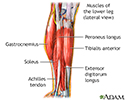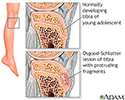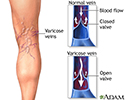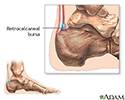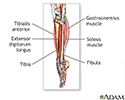Leg pain
Pain - leg; Aches - leg; Cramps - leg
Leg pain is a common problem. It can be due to a cramp, injury, or other cause.
Causes
Leg pain can be due to a muscle cramp (also called a charley horse). Common causes of cramps include:
- Dehydration or low amounts of potassium, sodium, calcium, or magnesium in the blood
- Medicines (such as diuretics and statins)
- Muscle fatigue or strain from overuse, too much exercise, or holding a muscle in the same position for a long time
An injury can also cause leg pain from:
- A torn or overstretched muscle (strain)
- Hairline crack in the bone (stress fracture)
- Inflamed tendon (tendinitis)
- Shin splints (pain in the front of the leg from overuse)
Other common causes of leg pain include:
- Peripheral artery disease (PAD), which causes a problem with blood flow in the legs (this type of pain, called claudication, is generally felt when exercising or walking and is relieved by rest)
- Blood clot (deep vein thrombosis) from long-term bed rest
- Infection of the bone (osteomyelitis) or skin and soft tissue (cellulitis)
- Inflammation of the leg joints caused by arthritis or gout
- Nerve damage common to people with diabetes, smokers, and alcoholics
- Varicose veins
Less common causes include:
- Cancerous bone tumors (osteosarcoma, Ewing sarcoma)
- Legg-Calve-Perthes disease -- poor blood flow to the hip that may stop or slow the normal growth of the leg
- Noncancerous (benign) tumors or cysts of the femur or tibia (osteoid osteoma)
- Sciatic nerve pain (radiating pain down the leg) caused by a slipped disk in the back
- Slipped capital femoral epiphysis -- most often seen in boys and overweight children between ages 11 and 15
Home Care
If you have leg pain from cramps or overuse, take these steps first:
- Rest as much as possible.
- Elevate your leg.
- Apply ice for up to 15 minutes. Do this 4 times per day, more often for the first few days.
- Gently stretch and massage cramping muscles.
- Take over-the-counter pain medicines such as acetaminophen or ibuprofen.
Other homecare will depend on the cause of your leg pain.
When to Contact a Medical Professional
Contact your health care provider if:
- The painful leg is swollen or red.
- You have a fever.
- Your pain gets worse when you walk or exercise and improves with rest.
- The leg is black and blue.
- The leg is cold and pale.
- You are taking medicines that may be causing leg pain. DO NOT stop taking or change any of your medicines without talking to your provider.
- Self-care steps do not help.
What to Expect at Your Office Visit
Your provider will perform a physical exam and look at your legs, feet, thighs, hips, back, knees, and ankles.
Your provider may ask questions such as:
- Where on the leg is the pain? Is the pain in one or both legs?
- Is the pain dull and aching or sharp and stabbing? Is the pain severe? Is the pain worse at any time of day?
- What makes the pain feel worse? Does anything make your pain feel better?
- Do you have any other symptoms such as numbness, tingling, back pain, or fever?
Your provider may recommend physical therapy for some causes of leg pain.
References
Anthony KK, Schanberg LE. Musculoskeletal pain syndromes. In: Kliegman RM, St. Geme JW, Blum NJ, Shah SS, Tasker RC, Wilson KM, eds. Nelson Textbook of Pediatrics. 21st ed. Philadelphia, PA: Elsevier; 2020:chap 193.
Hogrefe C, Terry M. Leg pain and exertional compartment syndromes. In: Miller MD, Thompson SR. eds. DeLee, Drez, & Miller's Orthopaedic Sports Medicine. 5th ed. Philadelphia, PA: Elsevier; 2020:chap 113.
Silverstein JA, Moeller JL, Hutchinson MR. Common issues in orthopedics. In: Rakel RE, Rakel DP, eds. Textbook of Family Medicine. 9th ed. Philadelphia, PA: Elsevier Saunders; 2016:chap 30.
Smith G, Shy ME. Peripheral neuropathies. In: Goldman L, Schafer AI, eds. Goldman-Cecil Medicine. 26th ed. Philadelphia, PA: Elsevier; 2020:chap 392.
Weitz JI, Ginsberg JS. Venous thrombosis and embolism. In: Goldman L, Schafer AI, eds. Goldman-Cecil Medicine. 26th ed. Philadelphia, PA: Elsevier; 2020:chap 74.
White CJ. Atherosclerotic peripheral arterial disease. In: Goldman L, Schafer AI, eds. Goldman-Cecil Medicine. 26th ed. Philadelphia, PA: Elsevier; 2020:chap 71.
Lower leg muscles - illustration
Lower leg muscles
illustration
Leg pain (Osgood-Schlatter) - illustration
Leg pain (Osgood-Schlatter)
illustration
Shin splints - illustration
Shin splints
illustration
Varicose veins - illustration
Varicose veins
illustration
Retrocalcaneal bursitis - illustration
Retrocalcaneal bursitis
illustration
Lower leg muscles - illustration
Lower leg muscles
illustration
Lower leg muscles - illustration
Lower leg muscles
illustration
Leg pain (Osgood-Schlatter) - illustration
Leg pain (Osgood-Schlatter)
illustration
Shin splints - illustration
Shin splints
illustration
Varicose veins - illustration
Varicose veins
illustration
Retrocalcaneal bursitis - illustration
Retrocalcaneal bursitis
illustration
Lower leg muscles - illustration
Lower leg muscles
illustration
Review Date: 7/19/2021
Reviewed By: Linda J. Vorvick, MD, Clinical Associate Professor, Department of Family Medicine, UW Medicine, School of Medicine, University of Washington, Seattle, WA. Also reviewed by David Zieve, MD, MHA, Medical Director, Brenda Conaway, Editorial Director, and the A.D.A.M. Editorial team.













